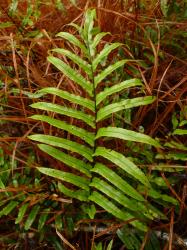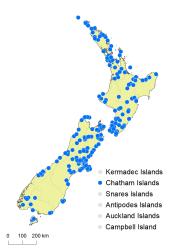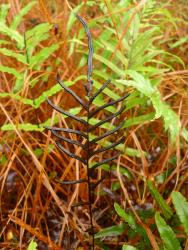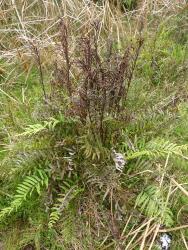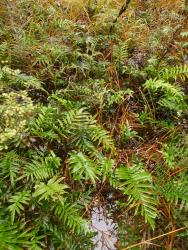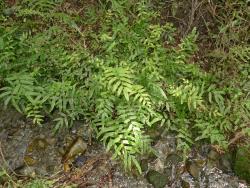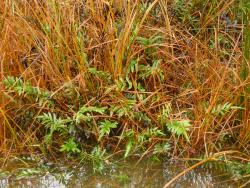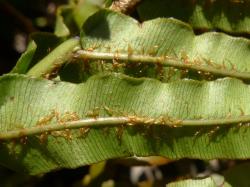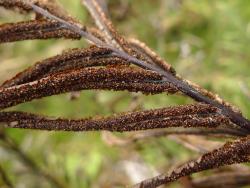- ≡ Stegania minor R.Br., Prodr. Fl. Nov. Holland. 153 (1810)
- ≡ Lomaria minor (R.Br.) Spreng., Syst. Veg., ed. 16, 4, 65 (1827)
- ≡ Lomaria procera var. minor (R.Br.) Hook.f., Bot. Antarct. Voy. II (Fl. Nov.-Zel.) Part II, 27, t. 75 (1854)
- ≡ Lomaria capensis var. minor (R.Br.) Cheeseman, Man. New Zealand Fl. 981 (1906)
- ≡ Blechnum capense var. minus (R.Br.) Domin, Biblioth. Bot. 20(85): 116 (1913)
- ≡ Parablechnum minus (R.Br.) Gasper & Salino in Gasper et al., Phytotaxa 275: 216 (2016)
- = Lomaria procera var. gracilis Colenso, Trans. & Proc. New Zealand Inst. 25: 323 (1893)
Rhizomes erect, up to 115 mm long, or creeping, up to 180 mm long (in herbarium material), bearing scales. Rhizome scales narrowly ovate, 3–7 mm long, 1–2 mm wide, chestnut-brown, concolorous or occasionally slightly bicolorous with paler margins. Fronds strongly dimorphic; sterile fronds 100–1400 mm long, or rarely only 45 mm in diminutive plants, arching outwards; fertile fronds on same plant equalling or longer than the sterile fronds, 100–1700 mm long, or rarely only 50 mm, positioned centrally, held upright. Sterile fronds. Stipes 20–425 mm long, or rarely only 10 mm long, sometimes black-brown at extreme base but mostly yellow-brown, bearing narrowly ovate chestnut-brown concolorous scales. Rachises yellow-brown, grooved adaxially, scaly. Laminae 80–1000 mm long, 20–310 mm wide, or rarely only 35 mm long and 10 mm wide, 1-pinnate, elliptic, with an undivided apical segment, bright green, similar colour on both surfaces, red-tinged when young, coriaceous; scales on abaxial pinna costae concolorous, pale chestnut-brown. Pinnae in 3–27 pairs, widely spaced, narrowly oblong, straight, markedly reduced to small rounded lobes at the lamina base; the longest pinnae at or just above the middle 10–190 mm long, 6–18 mm wide, or rarely only 7 mm long and 4 mm wide, apices acute or obtuse or rounded, margins entire or minutely crenate, bases truncate, short-stalked; the basal pinnae opposite. Veins free. Fertile fronds. Stipes 40–760 mm long, or rarely only 15 mm in diminutive plants. Laminae 35–600 mm long, 6–200 mm wide. Pinnae in 4–28 pairs, linear, straight, 10–140 mm long, or rarely only 4 mm long, 1–4 mm wide; short, sterile, proximal flanges present on the lower pinnae; 1–4 pairs of pinnae at the base of the lamina replaced by short, rounded, sterile lobes. Sori and indusia in one row either side of costa, continuous along most of the length of the pinna except for the proximal sterile flanges.
Note: Very small dimensions are from diminutive plants on pākihi soil; largest dimensions are from plants in swamps growing up through other tall vegetation (e.g. CHR 159613).
The swamp kiokio is very closely related to B. novae-zelandiae. It is distinguished by its slender and rather spindly form. In contrast to B. novae-zelandiae, the rhizome is often erect, the sterile laminae are much smaller (80–1000 mm long, 20–310 mm wide; cf. 150–2125 mm long, 65–740 wide), the sterile pinnae much narrower (6–18 mm wide, cf. 9–30 mm wide) and more widely spaced, and the number of pinna pairs fewer (3–27, cf. 7–53). The stipe scales and abaxial costa scales are concolorous, lacking the characteristic “black spot” of B. novae-zelandiae. The fertile pinnae have less pronounced proximal sterile flanges, and there are only 1–4 pairs of sterile lobes at the base of the fertile laminae compared to 2–9 in B. novae-zelandiae. It is further distinguished by growing in swamp or poorly drained habitats, in contrast to B. novae-zelandiae, which characteristically grows on banks, road cuttings, cliffs and rock faces, and along tracks and streambanks, as well as occupying swampy habitats.
North Island: Northland, Auckland, Volcanic Plateau, Gisborne, Taranaki, Southern North Island.
South Island: Western Nelson, Sounds-Nelson, Marlborough, Westland, Canterbury, Otago, Southland, Fiordland.
Three Kings Islands, Chatham Islands, Stewart Island.
Altitudinal range: 0–1040 m.
Blechnum minus occurs on the Three Kings Islands and in lowland to montane areas of the North Island from Te Paki to Wellington, but is absent from much of the central North Island and Gisborne. It occurs from near sea level, up to 1040 m in the northern Raukūmara Ranges. It is widespread in the South Island, but absent from much of the drier parts of south Canterbury and Otago, and very scattered in the far south. It reaches 600 m in the Chalk Range, Marlborough. It also occurs on Stewart Island and the Chatham Islands.
Also Australia (South Australia, New South Wales, Victoria, Tasmania).
Blechnum minus is a terrestrial fern found in podocarp, broadleaved and beech forest, under mānuka and kānuka, in scrub, under willows, and in open areas. It grows in swamps and bogs, on the margins of swamps and lakes, in ditches, in impeded streams, on peat, in damp hollows, on stabilised dunes, on wet ground, and on river banks and flood plains, often amongst Phormium, raupō, and sedges.
It is likely that Blechnum minus and B. novae-zelandiae hybridise in swampy areas, where the two species often occur together (e.g. CHR 145524). Blechnum minus may also hybridise occasionally with B. procerum (e.g. WELT P029462).
n = 28 (Brownlie 1954 – as B. procerum); 2n = 56 (Murray & de Lange 2013). Brownlie’s count of n = 28 was listed by Dawson et al. (2000) under B. novae-zelandiae, but the voucher specimen (CHR 396424) is a plant of B. minus from Lake Mahinapua, Westland.
This plant has been variously referred to as the swamp kiokio (Brownsey & Smith-Dodsworth 1989, 2000) or the swamp form of Blechnum novae-zelandiae (Chambers & Farrant 1998b). It was first recognised in New Zealand by Colenso (1893), who collected it from the margin of a low wood, on the edge of the great plain south of Dannevirke, and described it as Lomaria procera var. gracilis. Colenso’s description, and the type specimen (K 001092716), leave no doubt that it is the same as those identified later as the swamp form or swamp kiokio.
Chambers & Farrant (1998b) did not fully resolve the identity of this entity, but they referred to it as the swamp form of Blechnum novae-zelandiae, and included Colenso’s Lomaria procera var. gracilis in synonymy. They described plants as spindly with well-spaced pinnae, poorly developed auricles, and the rhizome tending to form a small, vertical trunk. However, Brownsey & Smith-Dodsworth (1989, 2000) had earlier referred such plants to the Australian species B. minus (R.Br.) Ettingsh. on the basis of their concolorous scales, rather than scales with conspicuous black centres characteristic of B. novae-zelandiae. Although Chambers & Farrant (1998b) accepted that New Zealand and Australian material shared concolorous scales, they noted that “unlike B. minus some swamp kiokio plants have scales tending towards ‘black-spot’”. They concluded that “the swamp form is not identical with the Australian B. minus, otherwise it would be expected to be more widespread in New Zealand in habitats other than swamps”.
DNA sequence data has not helped in resolving these relationships. It merely confirms that the three entities are very closely related (Perrie et al. 2014). More sophisticated analysis is required to provide better resolution.
In the meantime, we prefer to ally the New Zealand swamp form with the Australian B. minus, rather than with the New Zealand B. novae-zelandiae. The most convincing character that distinguishes the swamp form is the presence of concolorous scales on the costae, rachises and stipes. These are identical to those in B. minus, and quite different to the “black-spot” scales of B. novae-zelandiae. It is likely that those plants identified by Chambers & Farrant as having scales tending towards “black-spot” are actually hybrids, occurring in places where the two taxa occur together. The relatively small and spindly forms of the swamp form in New Zealand are very similar to small plants of B. minus in Australia, and indeed to the type material first collected by Robert Brown (BM 001048221, BM 00093974). However, it has to be acknowledged that the plant does not grow as large in New Zealand as it does in Australia, nor occupy such a wide range of habitats. This may be because those habitats are already occupied by B. novae-zelandiae, and that it is only in swampy habitats that B. minus can compete and survive.
An alternative possibility is that the swamp form is actually a third species. However, on present evidence there are insufficient characters to distinguish it from both B. minus and B. novae-zelandiae. Further investigation is required to confirm the status of the plants, which are treated here as belonging to B. minus.



